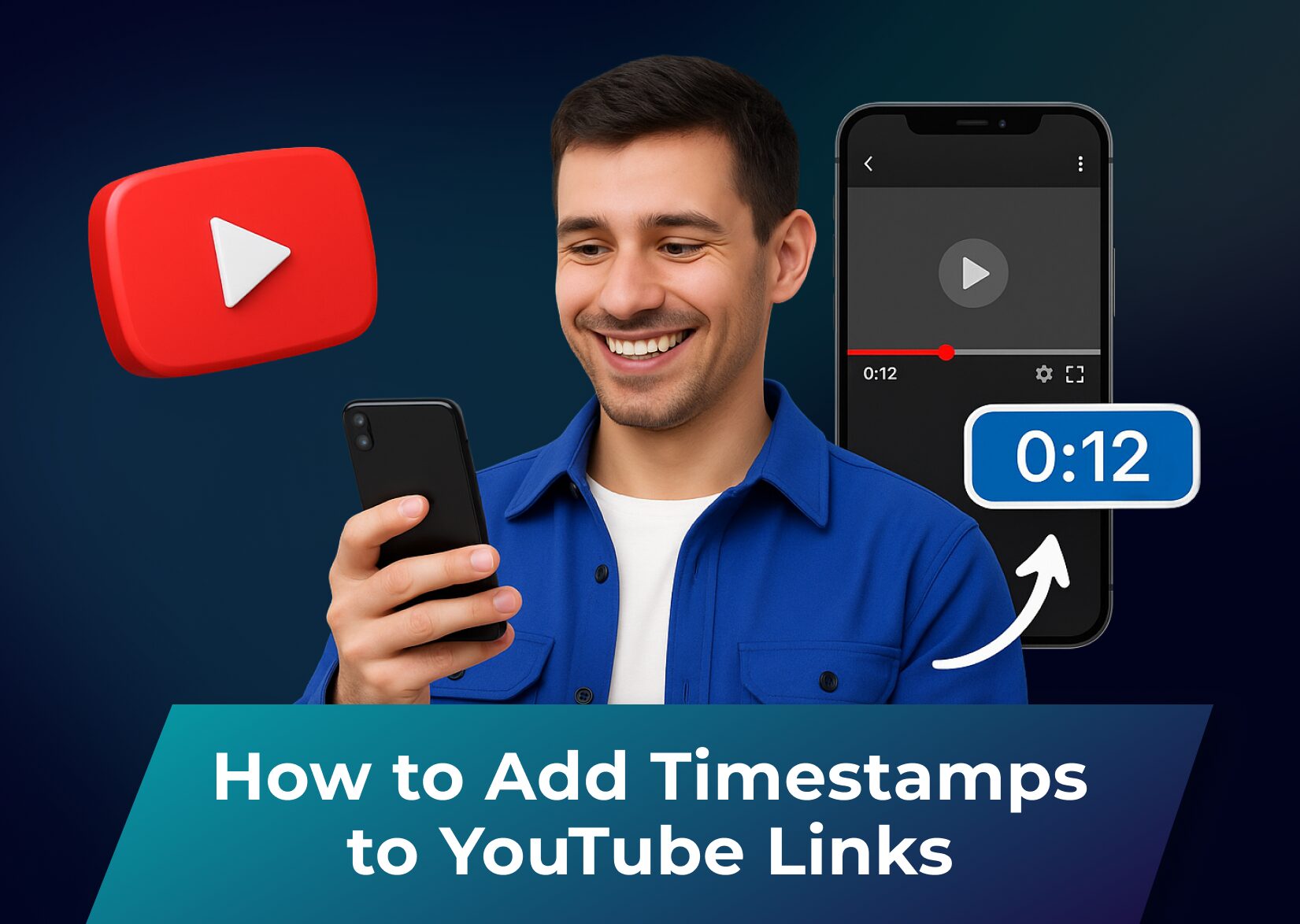How to Add Timestamps to YouTube Links: Quick Guide for Easy Video Navigation

Ever wanted to share a specific moment from a YouTube video without making your friends watch the entire thing? Adding timestamps to YouTube links lets you jump straight to the good stuff with just a click, allowing you to create a YouTube experience that is more engaging.
Whether you’re sharing a funny scene discussing a key point or referencing a particular segment, timestamps are incredibly useful. They save time and enhance the viewing experience for everyone. You’ll be happy to know it’s super easy to add timestamps to any YouTube video, and we’ll show you exactly how to do it.
Table of Contents
Key Takeaways
- YouTube timestamps allow viewers to jump directly to specific moments in a video by adding time markers in HH:MM:SS format to the URL or video description.
- Two main methods exist for adding timestamps: manually typing them in comments/descriptions (e.g., 1:45 or 01:45) or using YouTube Studio’s built-in chapter markers feature.
- Creating shareable timestamped links requires adding “&t=XmYs” to the video URL, where X represents minutes and Y represents seconds (e.g., &t=2m30s).
- Best practices include starting with 0:00, maintaining chronological order, using clear descriptions, and including at least 3 timestamps for proper chapter markers.
- Common mistakes to avoid are incorrect time formats, non-sequential ordering, and missing context in timestamp descriptions.
Understanding YouTube Timestamps and Their Benefits
YouTube timestamps transform long videos into easily navigable content segments. A timestamp creates a clickable link that jumps to a specific moment in a video, marked in hours:minutes:seconds format (HH:MM:SS).
Key Advantages of Using Timestamps
- Saves viewing time: Links viewers directly to relevant content sections without watching the entire video.
- Improves content accessibility: Breaks down lengthy videos into digestible chapters.
- Enhances user experience: Creates quick navigation points for different topics or segments.
- Boosts engagement: Increases viewer retention by highlighting key moments.
- Simplifies sharing: Enables sharing specific video segments with exact start times.
Common Use Cases for Timestamps
- Tutorial breakdowns (e.g., steps in a cooking recipe)
- Podcast topic segments (e.g., different discussion points)
- Product review sections (e.g., features, pricing, comparison)
- Gaming highlights (e.g., boss fights, achievements, strategies)
- Conference presentations (e.g., speaker introductions, Q&A sessions)
Timestamp Format Structure
| Component | Format | Example |
| Hours | 2 digits | 01: |
| Minutes | 2 digits | 05: |
| Seconds | 2 digits | 30 |
| Complete Format | HH:MM:SS | 01:05:30 |
Adding Timestamps in YouTube Comments
YouTube comments offer two distinct methods to add timestamps that create clickable links for specific video moments. These timestamps, similar to YouTube chapters, help viewers navigate through content efficiently.
Manual Method for Timestamp Creation
- Click the comment box below the video
- Type the timestamp in HH:MM:SS format (example: 1:45 or 01:45)
- Add descriptive text before or after the timestamp
- Post the comment
The format automatically converts to a clickable link when:
- Using single digits for minutes (1:45)
- Using double digits with leading zero (01:45)
- Including hours for videos over 60 minutes (1:23:45)
Using YouTube’s Built-in Timestamp Feature
- Open YouTube Studio
- Select the video to timestamp
- Click “Show More” under the video description
- Navigate to “Chapter Markers”
- Enter timestamps with descriptions
YouTube Studio formatting requirements:
- List timestamps in chronological order
- Start with 0:00 for the first timestamp
- Include at least 3 timestamps
- Space each timestamp on a new line
- Add descriptive text after the timestamp
Example timestamp format:
0:00 Introduction
2:30 Main Topic
5:45 Key Points
10:15 Summary
| Element | Requirement |
| Minimum Segments | 3 chapters |
| First Timestamp | Must be 0:00 |
| Segment Length | 10 seconds minimum |
| Format | Hours:Minutes:Seconds |
| Description | Required after timestamp |
Creating Video Timestamp Links to Share
Adding timestamps to YouTube links enables sharing specific moments in videos through direct URLs. Here’s how to create timestamped links on different platforms.
Desktop Method for Generating Time-Stamped YouTube URLs
- Navigate to the YouTube video you want to share
- Pause the video at the exact moment you’d like viewers to start watching
- Click the “Share” button below the video
- Check the “Start at” box in the share menu
- Copy the automatically generated URL with the timestamp
Alternative manual method:
- Locate the video’s original URL
- Add “&t=XmYs” at the end of the URL
- X represents minutes
- Y represents seconds
Example: https://YouTube.com/watch?v=videoID&t=2m30s
Mobile Method for Timestamp Links
- Open the YouTube app on your mobile device
- Play the video to the desired starting point
- Tap the “Share” button
- Toggle “Start at current time”
- Select your sharing method
- Seconds only: &t=90s
- Minutes and seconds: &t=1m30s
- Hours, minutes, seconds: &t=1h30m15s
| Platform | Time Parameter Format | Example |
| Desktop | &t=XmYs | &t=2m30s |
| Mobile | &t=Xs or &t=XmYs | &t=150s or &t=2m30s |
| Both | ?t=X (seconds only) | ?t=150 |
Best Practices for Using YouTube Timestamps
Creating effective timestamps enhances video accessibility while maintaining professional presentation standards and can be tracked using YouTube analytics. Follow these guidelines to maximize the impact of your YouTube timestamps.
Formatting Tips for Clear Timestamps
- Begin each timestamp with a clear, descriptive title using 3-5 words
- Maintain consistent capitalization across all timestamp labels
- Use colons to separate hours, minutes, and seconds (2:30:45)
- Add a space between the timestamp and description (0:00 Introduction)
- List timestamps in chronological order starting from 0:00
- Include chapter markers at logical content breaks
- Keep descriptions concise yet informative
- Use consistent formatting for similar content sections
When to Use Timestamps Effectively
- Long-form content over 10 minutes
- Tutorial videos with multiple steps
- Product reviews covering different features
- Panel discussions with topic changes
- Live streams with multiple segments
- Educational content with distinct lessons
- Q&A sessions with different questions
- Performance videos with multiple songs
- Sports highlights with key moments
- Podcast episodes covering various topics
Here’s an example of good timestamps:
0:00 Introduction
2:15 Main Topic Overview
15:30 Step-by-Step Tutorial
35:45 Common Issues & Solutions
45:20 Final Tips
Common Timestamp Mistakes to Avoid
1. Incorrect Time Format
- Using periods instead of colons (1.30.45 vs. 1:30:45)
- Omitting leading zeros (1:2:3 vs. 01:02:03)
- Adding spaces between numbers (1: 30: 45)
2. Non-Chronological Order
- Listing timestamps randomly (5:00, 2:00, 8:00)
- Skipping sections in sequential content
- Mixing different video segments
3. Inaccurate Time Markers
- Setting timestamps beyond video length
- Marking times before content appears
- Using timestamps that don’t align with scene changes
4. Missing Context
- Writing vague descriptions (“Section 1” or “Part A”)
- Excluding key topic indicators
- Using single-word labels without explanation
5. Technical Errors
- Adding timestamps to unavailable videos
- Using incorrect URL parameters (&time= instead of &t=)
- Forgetting the equals sign in manual timestamps
6. Formatting Issues
- Inconsistent capitalization in descriptions
- Missing spaces between timestamps and descriptions
- Using special characters that break the link
7. Mobile-Specific Problems
- Creating desktop-format timestamps on mobile
- Using incompatible sharing methods
- Copying partial URLs that break the timestamp function
8. Comment Section Errors
- Posting timestamps without 0:00 as the first marker
- Including fewer than 3 timestamps
- Adding unnecessary text between timestamp entries
Ready to Create Timestamps for Effective Video Marketing?
Now you’re equipped with all the tools to create and share timestamped YouTube links like a pro, including utilizing YouTube’s share feature. Whether you’re making your content more accessible or simply helping viewers find specific moments, these skills will transform how you interact with YouTube videos.
Remember that proper formatting and clear descriptions are key to making your timestamps effective. By taking a few extra minutes to add well-organized timestamps, you’ll create a better viewing experience for your audience and potentially boost your video’s engagement.
Give it a try and watch how these simple additions make your YouTube content more user-friendly and shareable!
Want to make your Instagram posts more dynamic and eye-catching? Adding your own GIFs to Stories and posts is a great way to express yourself and engage with your followers. Whether you’re sharing a funny moment or highlighting important content, GIFs can help bring your Instagram presence to life.
While Instagram doesn’t directly support uploading GIF files, you can still share these animated gems through several creative methods. From using Instagram’s built-in GIF library to converting GIFs into video formats, there are multiple ways to add that perfect animated touch to your content. You’ll discover how to navigate these options and choose the best approach for your specific needs.
FAQ
What are YouTube timestamps?
YouTube timestamps are clickable links that allow viewers to jump directly to specific moments in a video. They use the hours:minutes:seconds (HH:MM:SS) format and can be added to video descriptions, comments, or shared links in the mobile app, making it easier to navigate through longer content.
How do I add timestamps to my YouTube video?
You can add timestamps in two ways: through YouTube comments by typing the time in HH:MM:SS format (e.g., 2:30) or using YouTube Studio’s built-in timestamp feature. For the latter, list timestamps chronologically, starting with 0:00, and include descriptive text for each marker.
Can I create timestamps on mobile devices?
Yes, you can add timestamps on mobile devices. Play the video to your desired point, tap the “Share” button, and toggle “Start at current time.” You can also manually add timestamps in comments using the same HH:MM:SS format as on the desktop.
Do timestamps work in YouTube comments?
Yes, timestamps in comments automatically convert to clickable links when properly formatted (HH:MM:SS). Make sure to type at least one second (0:01) and use colons, not periods, between numbers to ensure automatic timestamps work correctly. The timestamp will become clickable after posting the comment.
How many timestamps should I include in a video?
Include at least three timestamps for YouTube to recognize them officially. However, the ideal number depends on your video length and content structure and can also influence how viewers engage with your future videos. For longer videos (20+ minutes), adding more timestamps can help viewers navigate better.
What are the best practices for using timestamps?
Begin each timestamp with a clear description, maintain consistent capitalization, list them chronologically, and ensure accuracy. Use timestamps for key moments, chapter divisions, or important topics. Keep descriptions concise but informative.
Can I share a video URL with a specific timestamp?
Yes, you can share videos starting at specific times. On the desktop, click “Share,” check the “Start at” box, and copy the URL. On mobile, tap “Share” and toggle “Start at current time.” You can also manually add “&t=XmYs” to the video URL.
What are common timestamp mistakes to avoid?
Avoid using incorrect time formats (use colons, not periods), listing timestamps out of order, providing vague descriptions, and adding timestamps to unavailable videos. Also, ensure all timestamps are accurate and properly formatted before publishing in your browser.
More articles

150+ Best Vacation Instagram Captions to Make Your Travel Photos Pop
Planning your dream vacation is exciting, but finding the perfect words to accompany those stunning photos can be challenging. Whether you’re lounging on a tropical beach, exploring ancient ruins, or hiking breathtaking mountains, the right caption can elevate your Instagram post from ordinary to unforgettable. You’ve packed your bags for the family vacation, created memories, […]

175+ Unforgettable Prom Instagram Captions to Make Your Night Shine | 2025 Edition
Capturing the magic of prom night on Instagram requires more than just stunning photos – you need the perfect caption to complete your post. Whether you’re looking for something sentimental, funny, referencing your favorite song lyrics, or the photos from the dance floor, the right words can make your prom memories shine even brighter on […]

200+ Beach Instagram Captions: From Funny to Inspirational Quotes
Looking for the perfect words to pair with your beach photos? You’re not alone. A day at the shore isn’t truly complete until you’ve captured those sun-soaked moments and shared them with a caption that perfectly complements your vibe. Whether you’re posting golden hour selfies, documenting beach games, or showcasing those “sunkissed nose, sandy toes” […]